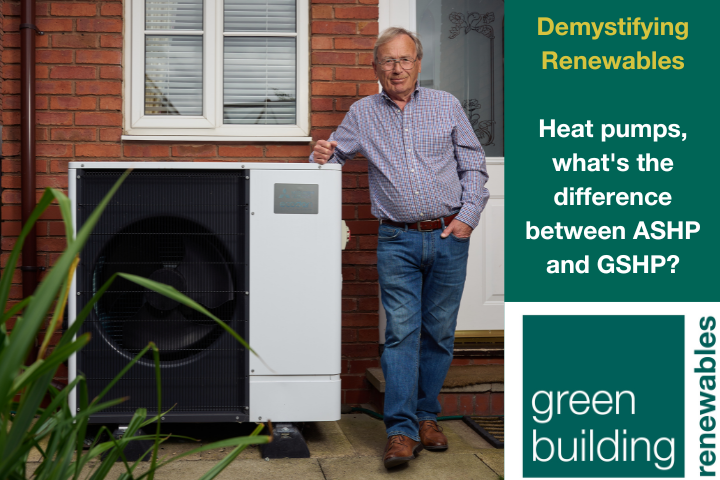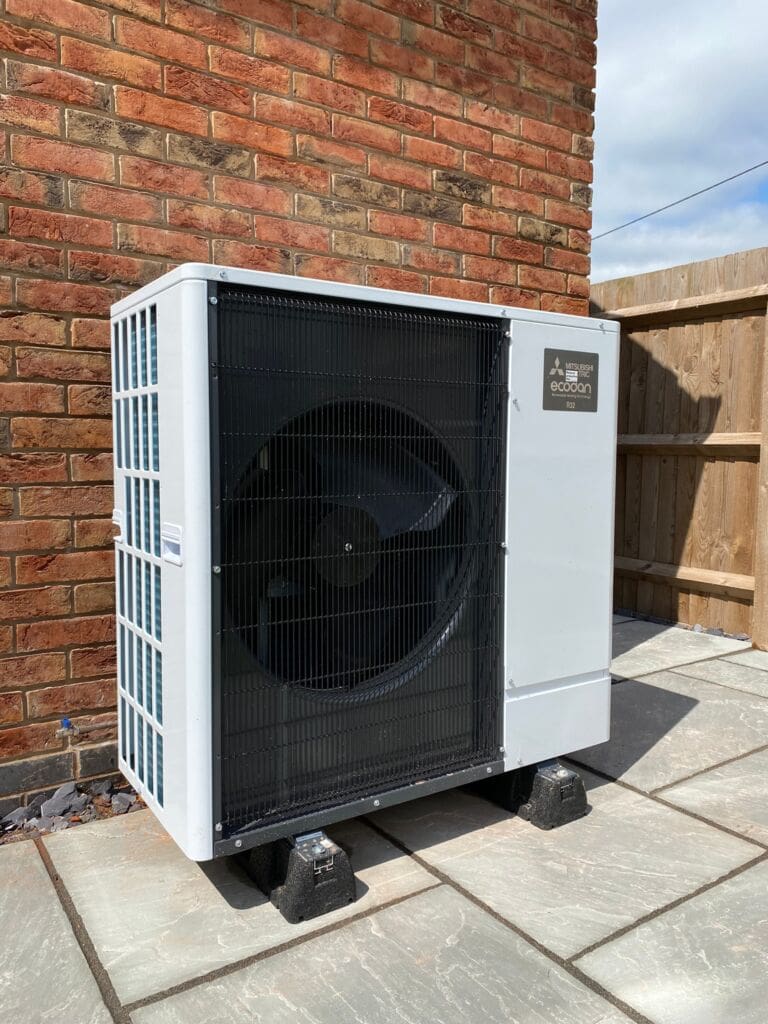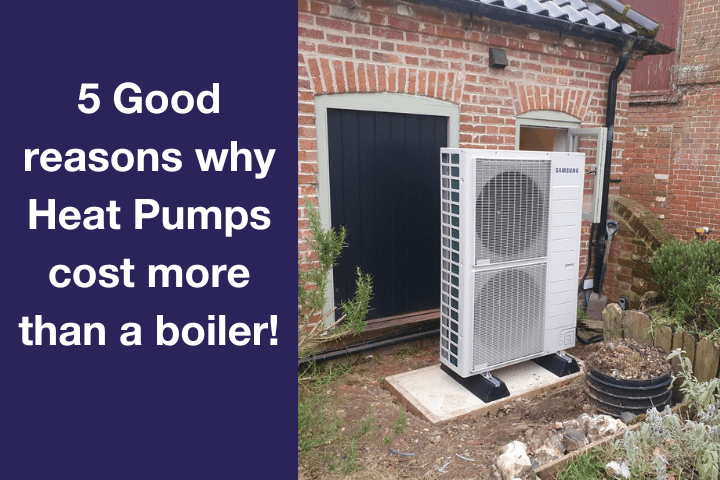Heat Pumps – What’s the Difference Between the 2 main types?

In recent years, there has been a growing interest in finding sustainable alternatives to traditional fossil fuels for heating our homes. Concerns about the environmental impact of gas boilers, in particular, as well as the UK government’s strategy to become net-zero emissions by 2050, have meant the concept of heat pumps has gained significant traction.
Heat pumps offer an innovative solution that not only provides effective heating and cooling but also minimises its environmental impact. In this blog we explain the differences between the two main types of heat pump.

Table of Contents
What are Heat Pumps?
Heat pumps extract heat from sources such as the air or the ground. By harnessing these renewable sources of thermal energy, they can provide both heating and cooling functions throughout the year without relying on fossil fuels or consuming excessive electricity. Heat pumps can achieve up to 300% efficiency by transferring three units of thermal energy for every unit of electricity consumed. Thanks to this remarkable efficiency, not only can we benefit from a reduction in our utility bills, but it also helps decrease greenhouse gas emissions associated with traditional heating methods.
In addition to their eco-friendly nature and cost-saving benefits, modern advancements have made heat pump technology more versatile. They are now available in various types: air-source, ground-source (ground-coupled) and water-source (geothermal) systems. This allows homeowners to choose a suitable option based on their needs and available resources.
If you’re looking for a more sustainable solution for your heating and hot water, in this guide, we’ll explore the most common types of heat pumps, Air Source Heat Pumps (ASHPs) and Ground Source Heat Pumps (GSHPs) and their benefits as well as potential drawbacks.
How Air Source Heat Pumps Work:
Air source heat pumps (ASHPs) are an eco-friendly heating solution that extracts heat from the ambient air and converts it to water, which is then used to heat your radiators, underfloor heating and hot water. The key component of an ASHP system is the compressor, which plays a crucial role in the heat transfer process.
One of the advantages of air source heat pumps is their ability to extract heat even in cold weather conditions, such as up to -270C. While they may not be as efficient as GSHPs, they can still provide significant energy savings compared to other traditional heating systems, including oil, gas and coal.
Additionally, ASHPs do not require extensive excavation like with GSHPs, making them easier and more cost-effective to install. They also have lower maintenance requirements compared to combustion-based heating systems.
However, it’s important to note that air source heat pumps have limitations. Their efficiency decreases as outdoor temperatures drop significantly below freezing. Although compared to other parts of Europe, the UK’s winter months are relatively warm.
They also require a hot water cylinder to store your hot water; unlike combination boilers, they don’t produce hot water on demand, so you’ll need a hot water tank that is adequate to store water for however many people are living in your household.
Furthermore, ASHPs require electricity to operate, so their overall environmental impact depends on how clean and sustainable your electricity supply is.
How Ground Source Heat Pumps Work:
Ground source heat pumps (GSHPs) work by harnessing the natural heat stored in the ground to provide heating and hot water. The key component of a GSHP system is the ground loop system. This system consists of a series of pipes buried underground, either in a closed-loop or open-loop configuration. In a closed-loop system, a mixture of water and antifreeze circulates through the pipes, absorbing heat from the ground in winter and transferring it to the building. Unlike ASHPs, a GSHP system is situated within the property alongside the hot water cylinder.
One advantage of GSHPs is their high efficiency. Since they rely on extracting heat from the ground rather than burning fossil fuels, they can achieve energy efficiencies of up to 400%. This means that up to four units of heat are generated for every unit of electricity used to power the pump.
However, there are some limitations to consider when installing GSHPs. The initial installation cost can be higher compared to conventional heating systems due to excavation and pipe installation requirements. The suitability of GSHPs also depends on factors such as soil conditions and available space for installation.
While there may be upfront costs and site-specific considerations involved, their long-term benefits make them an attractive option for homeowners seeking energy-efficient solutions.
Installation and Maintenance:
Installation and maintenance are crucial aspects to consider when it comes to both Air Source Heat Pumps (ASHPs) and Ground Source Heat Pumps (GSHPs). Let’s delve into the installation process for each system, along with the associated considerations, as well as the maintenance requirements for optimal performance.
When installing ASHPs, it is important to assess the available space. These systems typically require an outdoor unit that extracts heat from the air and an indoor unit that distributes it throughout the building. The outdoor unit should be placed in a location with adequate airflow and minimal obstructions. It is also essential to ensure that there is sufficient space for proper ventilation and maintenance access.
During installation, homeowners can expect minor disruptions, such as drilling or excavation work required for connecting refrigerant lines between the indoor and outdoor units. However, compared to GSHPs, ASHP installations generally involve less disruption as they do not require extensive groundwork or digging.
On the other hand, GSHP installations involve more complex procedures. They require drilling boreholes or trenches to install ground loops underground. This can be time-consuming and may cause more disruption during installation compared to ASHPs. Adequate space must be available for these ground loops, which can vary depending on soil conditions and system capacity.
Moving on to maintenance requirements, both ASHPs and GSHPs need regular upkeep to ensure optimal performance and longevity of the system. For ASHPs, routine tasks include cleaning or replacing air filters, topping up antifreeze, testing controls, and ensuring proper airflow around both indoor and outdoor units.
GSHP maintenance involves periodic checks of fluid levels in the ground loop system, along with inspections of pumps, valves, controls, and heat exchangers. It is important to monitor pressure differentials across these components as well.
Additionally, it’d advised that homeowners consider scheduling an annual service for both types of systems. This allows for a thorough inspection, cleaning, and fine-tuning of the system by qualified technicians.
Conclusion:
As you’ll have discovered, ASHPs and GSHPs are excellent ways to help reduce your energy reliance on the grid and live a more sustainable future. However, with several media outlets reporting misinformation about heat pumps, it’s worth looking at our myth-busting guide to learn more about how heat pumps are a fantastic way to live a more sustainable life that is kinder to the environment and your back pocket.
What’s more, thanks to the government’s current Boiler Upgrade System (BUS) scheme, eligible households in England and Wales could get £5,000 off the installation cost of their chosen heat pump system.
Here at Green Building Renewables, we can provide you with tailor-made environmentally-friendly solutions to meet your future energy needs. Take a look at our office locations to find your nearest installer to discuss your renewable energy needs.




